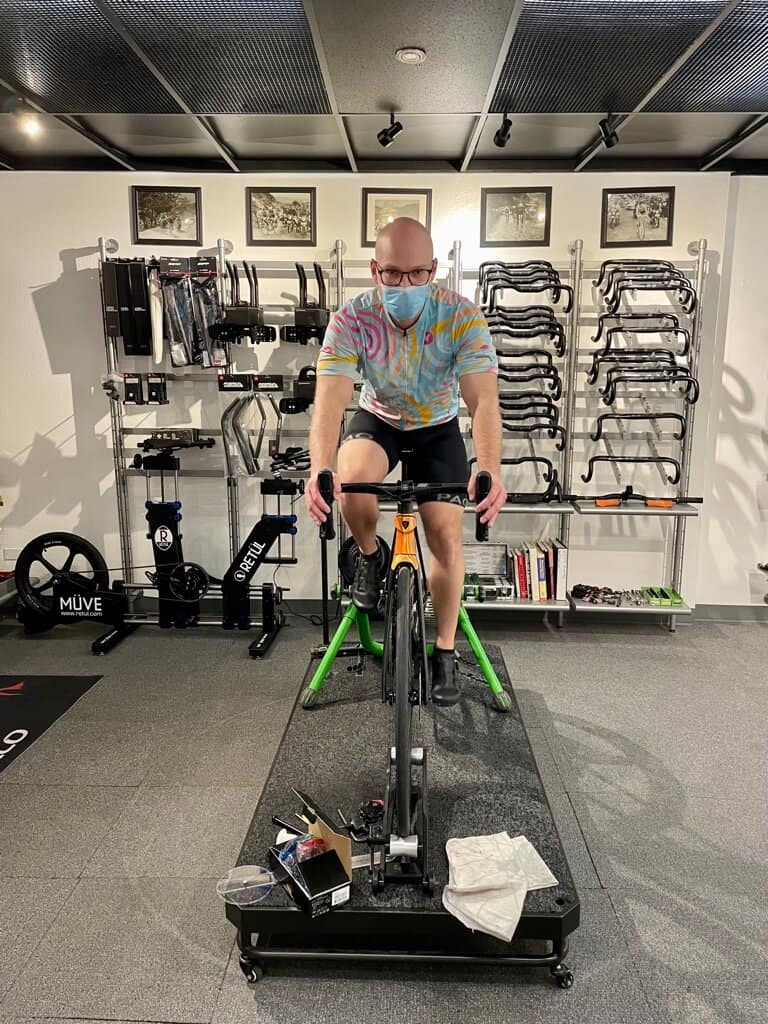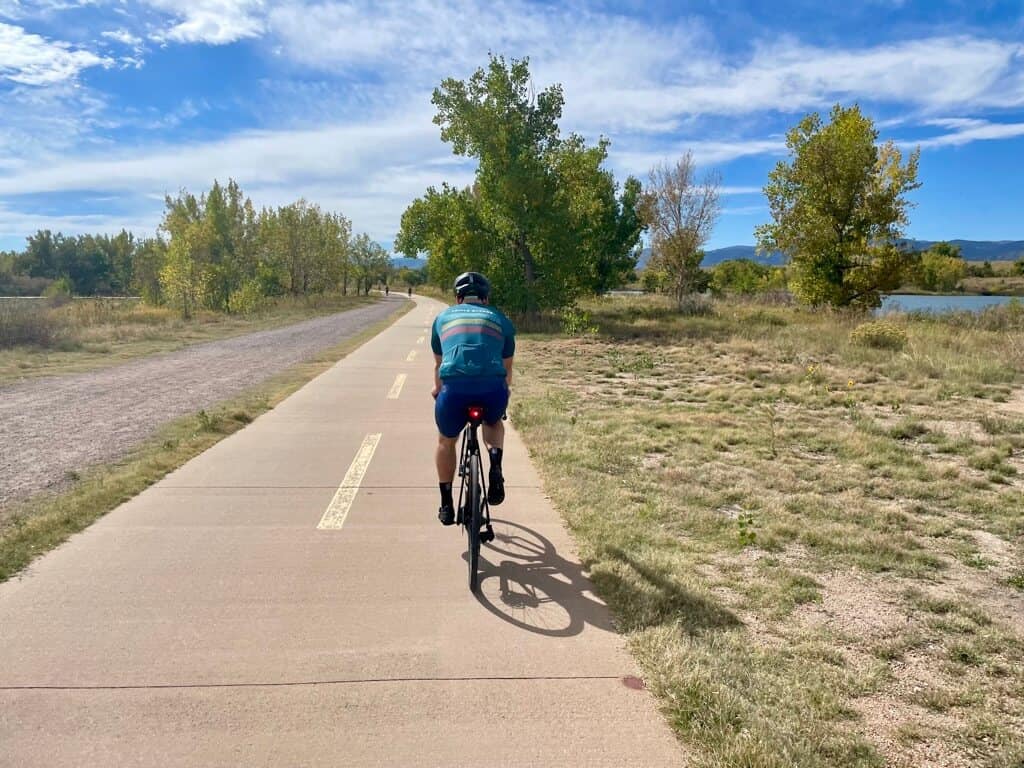We’ve all been there: out on a ride or race, enjoying the thrill of the moment or pushing ourselves to the limit, when suddenly we feel a tightening in our leg muscles. We try to shake it out or stretch it, but nothing helps. Before we know it, our quad, hamstring, or calf is completely locked up and we can’t move. If it’s as bad as mine, the Vastus Medialis Oblique (VMO) muscle has shifted to the middle of the quad, causing agony and ruining the ride.
I’ve suffered from leg cramps while cycling for as long as I’ve been in the sport. Not just the kind that stiffens up and then goes away on their own, but the kind that locks up the leg for minutes at a time and keeps coming back, effectively ending the ride.
On Father’s Day of 2022, my wife, best friend, and I were out on a bike ride. My in-laws were watching my daughter. We had just ridden 2.5 hours with 3,000 feet of climbing but still had another 20 miles planned with,1,500 more feet when one of those cramps hit me so hard that I had to call my father-in-law to come and pick me up.
It was an embarrassing moment, but I implemented some strategies and completed the 2023 Triple Bypass ride in Colorado, which was 118 miles and had 10,800 feet of climbing. It took me 9.5 hours of moving time to complete, but guess what? No cramps!
First, What are Leg Cramps?
Leg cramps, muscle cramps, or charley horses. They can happen in any muscle, but are more common in the legs, such as the calves, hamstrings, and quadriceps. Leg cramps can last from a few seconds to several minutes and often leave you feeling sore afterward sometimes for days. These can require us to add in additional recovery days, which keeps us off the bike, something Dads cannot afford to lose out on as our time is limited.
Why Do Leg Cramps Happen During Cycling?
- Dehydration: Dehydration is a common trigger for leg cramps during cycling. When you sweat, you lose not only water but also essential electrolytes like sodium, potassium, and magnesium. A lack of these electrolytes can lead to muscle cramps. Losing just 2% of body weight can cause a decline in performance and is indicative of dehydration.
- Overexertion/Undertrained: Pushing yourself too hard, especially if you’re not adequately trained or conditioned for long rides, can strain your muscles and increase the likelihood of cramps. After some trial and error, I determined that being undertrained for the level of exertion I was riding at was my biggest culprit.
- Improper Bike Fit: An ill-fitting bicycle can cause your body to adopt an awkward position, putting additional strain on certain muscle groups, and leading to cramps over time.
Preventing Leg Cramping While Cycling
It is important to note that modern sports science isn’t clear on any one cause but typically it is a combination of the factors listed above. The following can help prevent cramps.
- Bike Fit: It’s important to consult with a bike fitter to properly set up your bike for your body. This will decrease muscle strain while cycling. I have discussed this extensively in my blog post PROFESSIONAL BIKE FIT: WHY YOU NEED ONE AS A CYCLING DAD. Check it out if you haven’t yet.

- Flexibility: It’s important to maintain flexibility to prevent cramps and promote muscle health. When our muscles are flexible, they’re less likely to involuntarily tighten or contract, which is the main cause of cramps. Regular stretching and flexibility exercises keep muscles at an optimal length and range of motion, reducing the risk of muscle imbalances that can trigger cramps. Flexibility also improves blood circulation, ensuring that muscles receive enough oxygen and nutrients while preventing the buildup of waste products that can cause cramping. So, adding a flexibility routine to your fitness regimen improves agility and mobility, and helps prevent debilitating cramps. Stretching can be a fun activity to do with young kids. My two-year old loves stretching on the floor with me, and our stretching sessions often transition to a climb on Daddy session.
- Nutrition: Most modern cycling nutrition science says our bodies need 60-90 grams of carbs an hour, and this is just for us Dads cycling on the weekends. The professionals are taking in more! You can accomplish this with natural high-carb foods or with specific gel and bars made by companies. The following are some of my favorite products:
- Cookies: I love bringing real food on my rides to break up the sports drinks and gels. My favorite go-to food on the bike are my homemade chocolate chip cookies! They offer 20g of carbohydrates per cookie.
- Neversecond gels: When training for the Triple Bypass I tried a variety of gels. Many of them only have sources of carbohydrates either Glucose, Maltodextrin, or Fructose, which limits the amount of carbohydrates you can take in in an hour and requires water to digest. This is where I discovered Neversecond gels. Formulated using a 2:1 maltodextrin-to-fructose carbohydrate blend, their C30 gels deliver 30g of fast-absorbing carbohydrate with an exceptionally low risk of gastrointestinal distress.
- Fruits Snacks: Welch’s fruit snacks! Yes, the ones in the blue package from when you were a kid. These are easy to eat, cheap, and offer 22g of carbohydrates per package.
- Cookies: I love bringing real food on my rides to break up the sports drinks and gels. My favorite go-to food on the bike are my homemade chocolate chip cookies! They offer 20g of carbohydrates per cookie.

- Hydration: Hydration has two parts to it, water and electrolytes (sodium, potassium, magnesium, etc.). For exercise that is over an hour to an hour and a half, you want to aim for at least 16-24 ounces of water plus a serving of an electrolyte product that suits your needs each hour. Depending on the weather/climate and whether or not you are a more heavy/salty sweater, you may need to increase the amount of electrolytes and water you take in, as well!
- Scratch Labs: is one of the first sports drinks outside of Gatorade that I used. I like Scratch because it has a good variety of flavors (I like fruit punch and lemon-lime) and you can buy it in bulk and scoop what you want. It offers 20g of carbs per scoop and 380mg of sodium. You can easily put 2 scoops in a 500ml bottle and get some of your hourly carbohydrate intake in too.
- Drink LMNT: If you are like me, I get sick of all the sugar I need to consume. On longer rides, I just want a break from all that sugar and try to get it primarily from food. I, however, am a heavy sweater and need to replace my salt loss. That is where LMNT comes in. It contains 1000 mg sodium, 200 mg potassium, 60 mg magnesium, and zero sugar (Great for KETO). I love the raspberry salt flavor. Tip: If it is too salty you can split one serving between two bottles.
- Scratch Labs: is one of the first sports drinks outside of Gatorade that I used. I like Scratch because it has a good variety of flavors (I like fruit punch and lemon-lime) and you can buy it in bulk and scoop what you want. It offers 20g of carbs per scoop and 380mg of sodium. You can easily put 2 scoops in a 500ml bottle and get some of your hourly carbohydrate intake in too.
- Training: The goal is to build your endurance and train the body to ride at the efforts you will require of it. It’s important to start with shorter rides and gradually increase the duration and intensity. This allows your muscles to adapt and become stronger over time. Your training should be tailored to the type of riding you plan to do, whether it’s everyday cycling, a grand fondo, or a race. If you’ll be doing a lot of climbing, focus on climbing and riding at sweet-spot or threshold. For a grand fondo, work on riding at zone 2 for long periods. And for racing, interval training is key for the repeated efforts required. It’s also important to listen to your body. If you feel muscle fatigue or discomfort, ease off the intensity and consider incorporating rest days into your training schedule. By paying attention to your body’s signals and following a comprehensive training plan, you can greatly decrease the chance of experiencing cramps during your cycling adventures.
I would love to hear what your experiences have been with cramps. What has worked well for you? Drop a comment below.
Note: The information provided in this blog post is based solely on my personal experiences and research. It should not be considered a substitute for professional medical or nutritional advice. What worked for me may not work for you.

